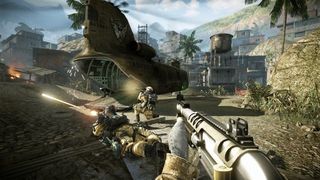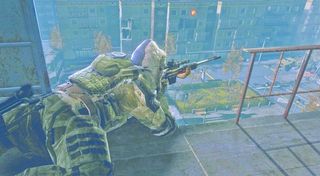Warface hands-on: the silliest name in games conceals a F2P shooter of serious ambition

Assault rifles, pistols and SMGs handle well, and I also got a kick out of a silenced semi-automatic sniper rifle. When the game's weapons lack punch – as in the case of certain shotguns – Warface compensates with the largest hit indicator I've ever seen, a great big flashing X rendered in red that leaves you in no doubt whatsoever that you've just shot a man in the face.
There's an unabashed willingness to provide the shooter player with what they want, particularly in terms of feedback. Crytek understands that feeling rewarded for playing well is just as important as having the tools to do the job. Warface works best when thought of as a service – a readily accessible supply of gunpowder and dopamine, separated out from the unnecessary extras that are tagged on to the average boxed shooter.
Warface's original ideas mostly manifest in terms of the way you negotiate the map. The most enjoyable of these is the slide, which allows you to dive out of sprint and scoot along the ground on your backside while unloading with whatever weapon you have to hand. In my time with the game, I fell in love with this move a little bit. Sliding past an enemy while firing a pistol is one thing; sliding into an enemy while swinging an axe is another, and sliding off an overpass while firing an anti-aircraft missile launcher at a circling helicopter in co-op mode is firm proof that Warface's tongue is at least partly in its cheek.

Then there are co-op mantling points, highlighted areas on each map that two players can climb by working together. This involves one player giving the other a leg up before being hoisted up themselves, and it unlocks extra routes and unique vantage points that can help teams bypass choke points or flank the enemy. While playing Warface's attack-and-defend mode, myself and another sniper took advantage of a climb point to move around the side of the defenders and prevent them from bedding down in cover around the objective.
"Warface isn't so much about survival as it is efficiency."
Full co-op Warface, however, is a different animal entirely. Teams of five players race through linear sections of the map, completing objectives and wiping out every enemy they see, racking up points as they go. Initial impressions suggest something analogous to Left 4 Dead or Payday: The Heist, but that isn't quite right: Warface isn't so much about survival and exploration as it is about efficiency, speed, and the primacy of the massive score combo multiplier that sits in the front and centre of the screen.
A better comparison would be a lightgun game like Time Crisis. Each map begins with the team arriving via Chinook helicopter, blasting enemies from the windows before haring off down a series of streets and narrow courtyards, joining back up with the helicopter, and being shuttled to the next section. Opposing soldiers pop out from behind cover and appear on rooftops with no heed for their own safety and little discernible strategy. Snipers and grenadiers might hold back and harass your squad from a distance, but the majority of troops will bunch up and push towards you in groups – groups whose implicit purpose is to be shot apart for precious, precious points.

The basic mechanics, weapons and loadouts of the game carry over from competitive play, so sliding around picking off foes with a shotgun is a viable way to earn bonus points. Class and weapon choices make a big difference: having a medic on your team allows for in-field revives, and the rifleman's ammo resupply pack keeps you moving when bullets run dry. Fallen teammates are revived automatically at checkpoints interspersed throughout each stage, but if you're all wiped out then it's game over.
The biggest gaming news, reviews and hardware deals
Keep up to date with the most important stories and the best deals, as picked by the PC Gamer team.
The arcade sensibility suits Warface, and the basic satisfaction of shooting people makes co-op an enjoyable diversion. I did find, however, that my choice of weapon greatly affected the score I was able to achieve. Armed with a versatile assault rifle or light machine gun, I was capable of dealing with enemies at multiple ranges – slowing down to line up a headshot on a distant sniper, then taking out a group of enemies mid-slide with full auto fire. With a shotgun, however, the only way was forward – and this led to situations where I'd either run in, get killed and need reviving, or hop around in the street attempting not to get shot while my teammates caught up and cleared out further-off enemies for me.
Then there are the boss battles. I saw two variants in my time with the game. In one, the team comes under attack from a helicopter and has to rush between missile launcher caches to whittle the chopper's health bar down, while regular enemies pile on from the sides. In the other, a single massive enemy appears wearing a combat exoskeleton. He's almost invulnerable from the front, so one player needs to distract him while the rest shoot at the glowing generator on his back. It's the most videogamey thing in the world, ever.
Joining in 2011, Chris made his start with PC Gamer turning beautiful trees into magazines, first as a writer and later as deputy editor. Once PCG's reluctant MMO champion , his discovery of Dota 2 in 2012 led him to much darker, stranger places. In 2015, Chris became the editor of PC Gamer Pro, overseeing our online coverage of competitive gaming and esports. He left in 2017, and can be now found making games and recording the Crate & Crowbar podcast.
Most Popular


